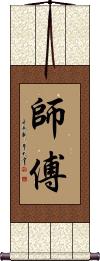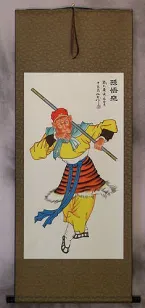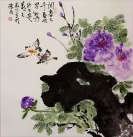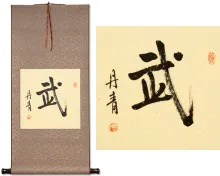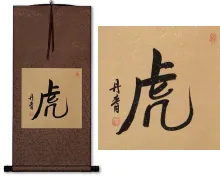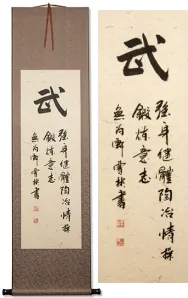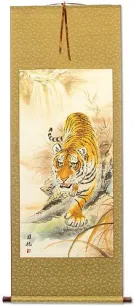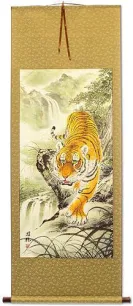Many custom options...
And formats...

The name Fu King in Chinese / Japanese...
Buy a Fu King calligraphy wall scroll here!
Personalize your custom “Fu King” project by clicking the button next to your favorite “Fu King” title below...
Drunken Monkey
醉猴 is the short title for Drunken Monkey (often used as a title for a style of martial arts or kung fu which mimics the movements of a drunk monkey).
This martial arts style was inspired by the novel, “Journey to the West.”
See Also: Monkey Fist
Drunken Monkey Kung Fu
醉猴功夫 is the title for Drunken Monkey Kung Fu (Gong Fu).
The martial arts style was inspired by the novel, “Journey to the West.”
See Also: Monkey Fist
Master / Skilled Worker
Secondary version of Sifu
師傅 is “sifu” as in the “master” in the context of martial arts.
But two sifu titles are floating around. This one can simply mean “skilled worker.”
Historically, this term has been used for many things, such as “The tutor of a king or emperor.” But now it's more commonly used to mean master worker or qualified worker.
Currently, within the field of skilled labor, a master (Shifu) is higher than a journeyman and is considered to be one worthy of teaching others.
Note: In the 1970s and 1980s, this term was used as a common form of polite address between people. You might say, “master, do you know where Tian'anmen Square is?” to a person on the street at that time. This usage has almost passed; however, for some reason, people still often refer to taxi cab drivers as “master” in China (though I think/hope this is fading).
In Mandarin Chinese, this is pronounced like “Sure Foo,” and in Cantonese, like “See Foo.”
The second character is the difference between this sifu and the other. In this case, the second character by itself means tutor, instructor, or teacher.
Monkey Fist
猴拳 literally means what you think, it's the “Monkey Fist” school of Kung Fu. A style that mimics the punches and movements of monkeys and apes.
Becoming popular during the Qing Dynasty, this style can trace its origins back to as early as the Song Dynasty. Some of the romance and popularity of this style comes from the novel “Journey to the West” which features the Monkey King and his fighting skills.
This novel and martial arts style has spawned a stream of Hong Kong movies featuring the Monkey King and other Kung Fu style variations such as “Drunken Monkey” and “Monkey Stealing Peaches” (a technique of disabling your opponent by grabbing and yanking on his testicles).
Note: This kind of makes sense in Korean Hanja and Japanese Kanji but probably unknown by all Koreans and Japanese except those who have an interest in this form of Kung Fu.
This in-stock artwork might be what you are looking for, and ships right away...
Gallery Price: $286.00
Your Price: $158.88
Gallery Price: $72.00
Your Price: $39.88
Gallery Price: $65.00
Your Price: $39.88
Gallery Price: $65.00
Your Price: $39.88
Gallery Price: $158.00
Your Price: $87.77
Gallery Price: $158.00
Your Price: $87.77
Not the results for fu king that you were looking for?
Below are some entries from our dictionary that may match your fu king search...
| Characters If shown, 2nd row is Simp. Chinese |
Pronunciation Romanization |
Simple Dictionary Definition |
力 see styles |
lì li4 li ryoku りょく |
More info & calligraphy: Power / Strength(suffix) strength; power; proficiency; ability; (given name) Riki bala; power, strength, of which there are several categories: 二力 power of choice and of practice; 三力 the power of Buddha; of meditation (samādhi) and of practice. 五力 pañcabala, the five powers of faith, zeal, memory (or remembering), meditation, and wisdom. 六力 A child's power is in crying; a woman's in resentment; a king's in domineering; an arhat's in zeal (or progress); a Buddha's in mercy; and a bhikṣu's in endurance (of despite) . 十力 q.v. The ten powers of Buddhas and bodhisattvas. |
牛 see styles |
niú niu2 niu ushi(p); gyuu; ushi / ushi(p); gyu; ushi うし(P); ぎゅう; ウシ |
More info & calligraphy: Ox / Bull / Cow(1) cattle (Bos taurus); cow; bull; ox; calf; (2) {food} (usu. ぎゅう) (See 牛肉) beef; (3) (ぎゅう only) {astron} (See 二十八宿,玄武・げんぶ・2) Chinese "Ox" constellation (one of the 28 mansions); (surname) Niu go, gaus; ox, bull, bullock, etc. A term applied to the Buddha Gautama as in 牛王 king of bulls, possibly because of the derivation of his name; the phrase 騎牛來牛 (or 騎牛覔牛) to ride an ox, to seek an ox, means to use the Buddha to find the Buddha. |
玉 see styles |
yù yu4 yü gyoku ぎょく |
More info & calligraphy: Jade(1) (also formerly read as ごく) precious stone (esp. jade); (2) {food} (occ. ギョク) egg (sometimes esp. as a sushi topping); (3) stock or security being traded; product being bought or sold; (4) (See 建玉) position (in finance, the amount of a security either owned or owed by an investor or dealer); (5) geisha; (6) (abbreviation) (See 玉代) time charge for a geisha; (7) (abbreviation) {shogi} (See 玉将) king (of the junior player); (female given name) Hikaru Jade, a gem; jade-like, precious; you, your. |
王 see styles |
wàng wang4 wang ou / o おう |
More info & calligraphy: King(n,n-suf) (1) king; ruler; sovereign; monarch; (n,n-suf) (2) tycoon; magnate; champion; master; (n,n-suf) (3) (abbreviation) {shogi} (See 王将・おうしょう・1) king (of the senior player); (surname) Wan rāja, king, prince, royal; to rule. |
索 see styles |
suǒ suo3 so soo; sou / soo; so ソー; ソウ |
More info & calligraphy: Soe(counter) {mahj} counter for bamboo tiles; (given name) Saku Cord; to extort, express; the cord or noose of Guanyin by which she binds the good; the cord of the vajra-king by which he binds the evil; translit. sa. |
亞哈 亚哈 see styles |
yà hā ya4 ha1 ya ha |
More info & calligraphy: Yayha |
力士 see styles |
lì shì li4 shi4 li shih rikishi(p); rikiji(ok) りきし(P); りきじ(ok) |
More info & calligraphy: Sumo Wrestler(1) {sumo} sumo wrestler; rikishi; (2) strong man; (3) (abbreviation) {Buddh} (See 金剛力士) Deva king; (surname) Rikishi 力者 vīra. A strong or mighty man, hero, demigod. Used for the Licchavi, also 離車; 梨車 (or 黎車); 栗呫媻. The terms 力士城 and 力士生地 are defined as Kuśinagara. |
四大 see styles |
sì dà si4 da4 ssu ta shidai しだい |
More info & calligraphy: Shidai / Sida / Mahabhuta(1) {Buddh} the four elements (earth, water, fire, wind); (2) the human body; (3) Tao, heaven, earth and king mahābhūta, 四界; 四大界. The four elements of which all things are made; or the four realms; i. e. earth, water, fire, and wind (or air); they represent 堅, 濕, 煖, and 動 solid, liquid, heat, and motion; motion produces and maintains life. As 實 active or formative forces they are styled 四界 (四大界) ; as 假 passive or material objects they are 四大; but the 成實論 Satyasiddhi śāstra disputes the 實 and recognizes only the 假. |
天皇 see styles |
tiān huáng tian1 huang2 t`ien huang tien huang tennou / tenno てんのう |
More info & calligraphy: Emperor of JapanEmperor of Japan; (place-name) Tennou Deva-king; the Tang monk 道悟 Daowu of the 天皇 Tianhuang monastery at 荊州 Jingzhou. |
夫人 see styles |
fū ren fu1 ren5 fu jen fujin(p); bunin(ok); hashikashi(ok) ふじん(P); ぶにん(ok); はしかし(ok) |
More info & calligraphy: Fujin(1) (ふじん, はしかし only) (honorific or respectful language) wife; Mrs; madam; (2) (ふじん only) (archaism) wife of a nobleman (aristocrat, etc.); (3) (ふじん, ぶにん only) (archaism) consort of the emperor A wife; the wife of a king, i. e. a queen, devi. |
悟空 see styles |
wù kōng wu4 kong1 wu k`ung wu kung gokuu / goku ごくう |
More info & calligraphy: Wukong / Goku(surname, given name) Gokuu |
猴王 see styles |
hóu wáng hou2 wang2 hou wang |
More info & calligraphy: Monkey King |
王子 see styles |
wáng zǐ wang2 zi3 wang tzu ouji / oji おうじ |
More info & calligraphy: Prince(1) prince; (2) subordinate Kumano shrine; (female given name) Kimiko prince |
萬歲 万岁 see styles |
wàn suì wan4 sui4 wan sui |
More info & calligraphy: Banzai / Wansui |
西施 see styles |
xī shī xi1 shi1 hsi shih seishi / seshi せいし |
More info & calligraphy: Xishi / Xi Shi(personal name) Seishi |
龍神 龙神 see styles |
lóng shén long2 shen2 lung shen ryuujin / ryujin りゅうじん |
More info & calligraphy: Dragon SpiritA dragon-god, or spirit. |
キンク see styles |
kingu キング |
king; (personal name) King |
サウル see styles |
sauru サウル |
More info & calligraphy: Saul |
孫悟空 孙悟空 see styles |
sūn wù kōng sun1 wu4 kong1 sun wu k`ung sun wu kung songokuu / songoku そんごくう |
More info & calligraphy: Sun Wukong / Son Goku(1) (char) Sun Wukong (character in the classic Chinese novel Journey to the West); Monkey King; (2) (char) Son Goku (Dragon Ball); (ch) Sun Wukong (character in the classic Chinese novel Journey to the West); Monkey King; (ch) Son Goku (Dragon Ball) |
法魯克 法鲁克 see styles |
fǎ lǔ kè fa3 lu3 ke4 fa lu k`o fa lu ko |
More info & calligraphy: Faruq |
約西亞 约西亚 see styles |
yuē xī yà yue1 xi1 ya4 yüeh hsi ya |
More info & calligraphy: Josiah |
觀世音 观世音 see styles |
guān shì yīn guan1 shi4 yin1 kuan shih yin Kanzeon かんぜおん |
More info & calligraphy: Guan Shi Yin: Protector Of Life(out-dated kanji) Avalokiteshvara (Bodhisattva); Avalokitesvara; Kannon; Kwannon; Guanyin; Buddhist deity of compassion Regarder of the world's sounds, or cries, the so-called Goddess of Mercy; also known as 觀音; 觀世音善薩; 觀自在 (觀世自在); 觀尹; 光世音 (the last being the older form). Avalokiteśvara, v. 阿 8. Originally represented as a male, the images are now generally those of a female figure. The meaning of the term is in doubt; it is intp. as above, but the term 觀自在 (觀世自在) accords with the idea of Sovereign Regarder and is not associated with sounds or cries. Guanyin is one of the triad of Amida, is represented on his left, and is also represented as crowned with Amida; but there are as many as thirty-three different forms of Guanyin, sometimes with a bird, a vase, a willow wand, a pearl, a 'thousand' eyes and hands, etc., and, when as bestower of children, carrying a child. The island of Putuo (Potala) is the chief centre of Guanyin worship, where she is the protector of all in distress, especially of those who go to sea. There are many sūtras, etc., devoted to the cult, but its provenance and the date of its introduction to China are still in doubt. Chapter 25 of the Lotus Sūtra is devoted to Guanyin, and is the principal scripture of the cult; its date is uncertain. Guanyin is sometimes confounded with Amitābha and Maitreya. She is said to be the daughter of king Śubhavyūha 妙莊王, who had her killed by 'stifling because the sword of the executioner broke without hurting her. Her spirit went to hell; but hell changed into paradise. Yama sent her back to life to save his hell, when she was miraculously transported on a Lotus flower to the island of Poo-too'. Eitel. |
不動明王 不动明王 see styles |
bù dòng míng wáng bu4 dong4 ming2 wang2 pu tung ming wang fudoumyouou / fudomyoo ふどうみょうおう |
More info & calligraphy: Fudo Myo-o / Wisdom King不動尊 Aryacalanatha 阿奢羅曩 tr. 不動尊 and 無動尊 and Acalaceta, 阿奢囉逝吒 tr. 不動使者. The mouthpiece or messenger, e. g. the Mercury, of the Buddhas; and the chief of the five Ming Wang. He is regarded as the third person in the Vairocana trinity. He has a fierce mien overawing all evil spirits. He is said to have attained to Buddhahood, but also still to retain his position with Vairocana. He has many descriptive titles, e. g. 無量力神通無動者; 不動忿怒王, etc. Five different verbal signs are given to him. He carries a sharp wisdom-sword, a noose, a thunder-bolt. The colour of his images is various—black, blue, purple. He has a youthful appearance; his hair falls over his left shoulder; he stands or sits on a rock; left eye closed; mouth shut, teeth gripping upper lip, wrinkled forehead, seven locks of hair, full-bodied, A second representation is with four faces and four arms, angry mien, protruding teeth, with fames around him. A third with necklaces. A fourth, red, seated on a rock, fames, trident, etc. There are other forms. He has fourteen distinguishing symbols, and many dharanis associated with the realm of fire, of saving those in distress, and of wisdom. He has two messengers 二童子 Kimkara 矜羯羅 and Cetaka 制吒迦, and, including these, a group of eight messengers 八大童子 each with image, symbol, word-sign, etc. Cf. 不動佛. |
摩賀羅惹 摩贺罗惹 see styles |
mó hè luó rě mo2 he4 luo2 re3 mo ho lo je magaraja |
More info & calligraphy: Maharaja |
□ see styles |
ging ging1 ging |
uptight; obstinate; to awkwardly force oneself to do something (from Taiwanese, Tai-lo pr. [king], often written as ㄍㄧㄥ, no generally accepted hanzi form) |
仕 see styles |
shì shi4 shih shi し |
to serve as an official; an official; the two chess pieces in Chinese chess guarding the "general" or "king" 將|将[jiang4] official; civil service; (given name) Tsukou |
崩 see styles |
bēng beng1 peng nadare なだれ |
to collapse; to fall into ruins; death of king or emperor; demise (female given name) Nadare |
帥 帅 see styles |
shuài shuai4 shuai sochi; sotsu そち; そつ |
(bound form) commander-in-chief; (bound form) to lead; to command; handsome; graceful; dashing; elegant; (coll.) cool!; sweet!; (Chinese chess) general (on the red side, equivalent to a king in Western chess) (See 大宰府) director of the Dazaifu; (given name) Tsukasa |
朕 see styles |
zhèn zhen4 chen chin ちん |
(used by an emperor or king) I; me; we (royal "we"); (literary) omen (pronoun) (dated) (first person pronoun used by the Emperor) We |
龗 see styles |
okami おかみ |
(rare) water god; rain and snow god; dragon god; dragon king |
Click here for more fu king results from our dictionary
The following table may be helpful for those studying Chinese or Japanese...
| Title | Characters | Romaji (Romanized Japanese) | Various forms of Romanized Chinese | |
| Drunken Monkey | 醉猴 | zuì hóu / zui4 hou2 / zui hou / zuihou | tsui hou / tsuihou | |
| Drunken Monkey Kung Fu | 醉猴功夫 / 醉猴功伕 醉猴功夫 | zuì hóu gōng fu zui4 hou2 gong1 fu zui hou gong fu zuihougongfu | tsui hou kung fu tsuihoukungfu |
|
| Master Skilled Worker | 師傅 师傅 | shī fu / shi1 fu / shi fu / shifu | shih fu / shihfu | |
| Monkey Fist | 猴拳 | hóu quán / hou2 quan2 / hou quan / houquan | hou ch`üan / houchüan / hou chüan | |
| In some entries above you will see that characters have different versions above and below a line. In these cases, the characters above the line are Traditional Chinese, while the ones below are Simplified Chinese. | ||||
Successful Chinese Character and Japanese Kanji calligraphy searches within the last few hours...


